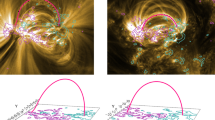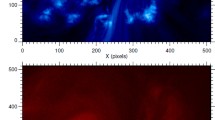Abstract
A model for quiescent areas of the solar atmosphere corresponding to radiation at wavelengths from 1 cm to 1 m is presented. The model includes a collection of loops of various sizes, spicules, and free (inter-loop) matter. The parameters for the free matter are approximated using the input height dependences of the temperature and electron density in the atmosphere, based on known models for quiescent regions at the center of the solar disk. The model contains 10 loops of the same type with radii R loop from 3100 to 210 000 km, with their occurrence frequency and the electron densities at their apices being the mean values for loops of a specified cluster of sizes. The loop density factor, defined as the number of loops of a given size in a 2R {ogloop} × 2R loop area, lies in the range from six to nine. The height of the beginning of the coronal parts of the loops h 0 is 2275 km. The height profile of the temperature of the coronal part of a loop is given by \(T_{l_p } (h) = T_{\min } + \left( {T_{\max loop} - T_{\min } } \right)\left\{ {\sin \left[ {\frac{\pi } {2}\left( {h - h_0 } \right)/\left( {R_{loop} - h_0 } \right)} \right]} \right\}^{0.25}\), where T min is the temperature of the initial model at height h 0 and T max loop is the temperature of the loop apex. Height profiles for the initial model taking into account (for the density) the pressure at height h 0 were used in the vicinity of the loop feet. The brightness was calculated by summing the brightnesses of individual layers of atmospheric components using a simple logical scheme, taking into account their probabilities and the overall transmission coefficient. The probability characteristics of the atmospheric components were found iteratively, by comparing the computed equatorial brightness distribution with the observational data. Good agreement between the theoretical brightness distributions and observational data obtained on the RATAN-600 telescope, the Nobeyama Radio Heliograph, and the Siberian Solar Radio Telescope has been obtained over a wide range of wavelengths for the first time.
Similar content being viewed by others
References
K. Shibasaki, C. E. Alissandrakis, and S. Pohjolainen, Solar Phys. 273, 309 (2011).
E. Fürst, O. Hachenberg, and W. Hirth, Astron. Astrophys. 36, 123 (1974).
J. P. Hagen, P. N. Swanson, R. W. Haas, F. L. Wefer, and R. W. Vogt, Solar Phys. 21, 286 (1971).
N. R. Labrum, J. W. Archer, and C. J. Smith, Solar Phys. 59, 331 (1978).
P. Lantos and M. R. Kundu, Astron. Astrophys. 21, 119 (1972).
V. N. Borovik, in Advances in Solar Physics, Ed. by G. Belvedere, M. Rodonò, and G. M. Simnett, Lect. Notes Phys. 432, 185 (1994).
M. Simon and H. Zirin, Solar Phys. 9, 317 (1969).
E. Fürst, P. Lantos, and W. Hirth, Solar Phys. 63, 257 (1979).
V. N. Borovik, M. Sh. Kurbanov, and V. V. Makarov, Sov. Astron. 36, 656 (1992).
G. Pineau des Forest, Astron. Astrophys. 78, 159 (1979).
V. V. Zheleznyakov, Radio Emission of the Sun and Planets (Nauka, Moscow, 1964) [in Russian].
K. V. Getman and M. A. Livshits, Astron. Rep. 40, 104 (1996).
I. M. Fontenla, E. H. Avrett, and R. Loeser, Astrophys. J. 406, 319 (1993).
J. A. Klimchuk, Solar Phys. 193, 53 (2000).
V. N. Borovik, M. Sh. Kurbanov, M. A. Livshits, and B. I. Ryabov, Sov. Astron. 34, 522 (1990).
M. Loukitcheva, S. K. Solanki, M. Carlsson, and R. F. Stein, Astron. Astrophys. 419, 747 (2004).
H. Zirin, B. M. Baument, and G. J. Hurford, Astrophys. J. 370, 779 (1991).
V. M. Bogod, A. S. Grebinskii, and L. V. Opeikina, Izv. Vyssh. Uchebn. Zaved., Radiofiz. 39, 1450 (1996).
A. Nindos, M. R. Kundu, S. M. White, D. E. Gary, K. Shibassaki, and K. P. Dere, Astrophys. J. 527, 415 (1999).
B. B. Krissinel, Astron. Rep. 49, 939 (2005).
B. I. Lubyshev, G. Ya. Smolkov, T. A. Treskov, B. B. Krissinel, N. N. Potapov, N. P. Kardapolova, and V. G. Miller, in Structure and Dynamics of Solar Coronae, Ed. by B. P. Filippov (Nauka, Troitsk, Moscow, 1999), p. 306.
C. L. Selhorst, A. V. R. Silva, and J. E. R. Costa, Astron. Astrophys. 420, 1117 (2004).
V. V. Grechnev, S. V. Lesovoi, G. Ya. Smolkov, B. B. Krissinel, V. G. Zandanov, A. T. Altyntsev, N. N. Kardapolova, R. Y. Sergeev, A. M. Uralov, V. P. Maksimov, and B. I. Lubyshev, Solar Phys. 216, 239 (2003).
M. R. Kundu, A. P. Rao, F. T. Erskine, and J. D. Bregman, Astrophys. J. 234, 1122 (1979).
K. A. Marsh, G. J. Hurford, and H. Zirin, Astron. Astrophys. 94, 67 (1981).
S. Serio, G. Peres, G. S. Vaiana, L. Golub, and R. Rosner, 243, 288 (1981).
H. M. Oluseyi, A. B. C. Walker, D. I. Santiago, R. B. Hoover, and T. W. Barber, Astrophys. J. 527, 992 (1999).
M. J. Aschwanden, C. J. Schrijver, and D. Alexander, Astrophys. J. 550, 1036 (2001).
D. D. Lenz, E. E. Deluca, L. Golub, R. Rosner, and J. A. Bookbinder, Astrophys. J. Lett. 517, L155 (1999).
M. Aubier, Y. Leblanc, and A. Boishhot, Astron. Astrophys. 12, 435 (1971).
Author information
Authors and Affiliations
Corresponding author
Additional information
Original Russian Text © B.B. Krissinel’, 2015, published in Astronomicheskii Zhurnal, 2015, Vol. 92, No. 1, pp. 66–79.
Rights and permissions
About this article
Cite this article
Krissinel’, B.B. Modeling of the structure of quiescent areas of the solar atmosphere emitting at 1–100 cm. Astron. Rep. 59, 58–71 (2015). https://doi.org/10.1134/S1063772915010060
Received:
Accepted:
Published:
Issue Date:
DOI: https://doi.org/10.1134/S1063772915010060




